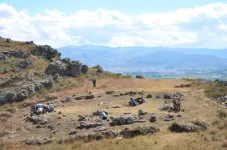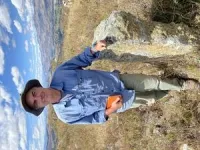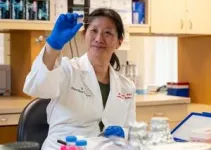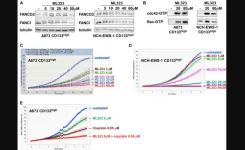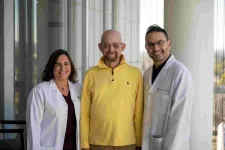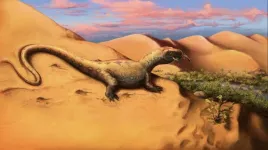(Press-News.org) Two University of Wyoming anthropology professors have discovered one of the earliest circular plazas in Andean South America, showcasing monumental megalithic architecture, which refers to construction that uses large stones placed upright with no mortar.
Located at the Callacpuma archaeological site in the Cajamarca Basin of northern Peru, the plaza is built with large, vertically placed megalithic stones -- a construction method previously unseen in the Andes. Associate Professor Jason Toohey, project lead, and Professor Melissa Murphy have been researching this topic since the project’s inception in 2015. Excavations took place in the plaza starting in 2018.
Their paper, which reports new data on this earliest known megalithic circular plaza in the northern Andes, is titled “A Monumental Stone Plaza at 4750 BP in the Cajamarca Valley of Peru” and has been published today (Feb. 14) in the peer-reviewed journal Science Advances.
Radiocarbon dating places its initial construction around 4,750 years ago during the Late Preceramic Period, making it one of the earliest instances of such architecture in the Americas.
To better understand this timeline, the team carefully excavated within the plaza, uncovering artifacts related to life in the past and collecting charcoal samples for dating. All material remains then were cleaned, processed and analyzed in the laboratory.
“This structure was built approximately 100 years before the Great Pyramids of Egypt and around the same time as Stonehenge,” Toohey says.
These dates signify that the circular plaza at Callacpuma is the earliest known example of monumental and megalithic architecture in the Cajamarca Valley -- and one of the earliest examples in ancient Peru.
“It was probably a gathering place and ceremonial location for some of the earliest people living in this part of the Cajamarca Valley,” Toohey adds. “These people were living a primarily hunting-and-gathering lifestyle and probably had only recently begun growing crops and domesticating animals.”
The plaza is formed by two concentric walls and measures about 60 feet in diameter.
The project is led by Toohey and Patricia Chirinos Ogata from the University of California-Santa Barbara. The team also includes Murphy, as well as undergraduate and graduate students from Peru and the U.S.
Toohey is an anthropological archaeologist who is dedicated to taking a holistic and multidisciplinary approach to the field. He has conducted fieldwork in the Peruvian Andes since 2003. The department head for anthropology at UW, Murphy is a biological anthropologist specializing in bioarchaeology and committed to multidisciplinary approaches within anthropology.
“As part of our community outreach, we collaborate and work with the residents of the towns on and adjacent to the site of Callacpuma about our findings and their importance,” Toohey says. “We highlight the importance of cultural heritage and, working together, we can continue the scientific investigations and help to preserve the site.”
To learn more about this project, email Toohey at jtoohey2@uwyo.edu.
END
UW anthropologists’ research unveils early stone plaza in the Andes
2024-02-14
ELSE PRESS RELEASES FROM THIS DATE:
New epigenetic clocks reinvent how we measure age
2024-02-14
BOSTON – What causes us to age? New “clocks” developed by researchers may help point to the answers. Investigators from Brigham and Women’s Hospital, a founding member of the Mass General Brigham healthcare system, unveil a new form of epigenetic clock – a machine learning model designed to predict biological age from DNA structure. The novel model distinguishes between genetic differences that slow and accelerate aging, predicts biological age and evaluates anti-aging ...
The roles of USP1 in Ewing sarcoma
2024-02-14
“This study uncovered important roles for USP1 in Ewing sarcoma.”
BUFFALO, NY- February 14, 2024 – A new research paper was published in Genes & Cancer on February 5, 2024, entitled, “Roles of USP1 in Ewing sarcoma.”
Ewing sarcoma is a cancer of bone and soft tissue in children and young adults that is driven by the EWS-ETS fusion transcription factor, most commonly EWS-FLI1.
Researchers Panneerselvam Jayabal, Xiuye Ma and Yuzuru Shiio from The University of Texas Health Science Center previously reported that Ewing sarcoma harbors two populations of cells, ...
New algorithm disentangles intrinsic brain patterns from sensory inputs
2024-02-14
Maryam Shanechi, Dean’s Professor of Electrical and Computer Engineering and founding director of the USC Center for Neurotechnology, and her team have developed a new machine learning method that reveals surprisingly consistent intrinsic brain patterns across different subjects by disentangling these patterns from the effect of visual inputs.The work has been published in the Proceedings of the National Academy of Sciences (PNAS).
When performing various everyday movement behaviors, such as reaching for a book, our brain has to take in information, often in the form of visual input — for example, seeing where the book is. Our brain then has to process ...
A new test could predict how heart attack patients will respond to mechanical pumps
2024-02-14
Every year, around 50,000 people in the United States experience cardiogenic shock — a life-threatening condition, usually caused by a severe heart attack, in which the heart can’t pump enough blood for the body’s needs.
Many of these patients end up receiving help from a mechanical pump that can temporarily help the heart pump blood until it recovers enough to function on its own. However, in nearly half of these patients, the extra help leads to an imbalance between the left and right ventricles, which can pose danger to the patient.
In a ...
Turning back the clock on photoaging skin
2024-02-14
Chronic exposure of human skin to ultraviolet light causes premature aging, or photoaging. As the skin undergoes photoaging, type I collagen bundles, which are found in the dermis beneath the top layer of the skin and provide strength and support to skin, become fragmented. This leads to wrinkles, fragility and loss of support and elasticity.
“The best way to prevent damage to type I collagen by sunlight is to wear sunscreen consistently, daily if possible and particularly when spending time outdoors,” said Frank Wang, MD, the William B. Taylor Endowed Professor of Clinical Dermatology at U-M Medical School.
Experts ...
City of Hope research featuring the successful treatment of the oldest patient to achieve remission for leukemia and HIV published in The New England Journal of Medicine (NEJM)
2024-02-14
LOS ANGELES — City of Hope®, one of the largest cancer research and treatment organizations in the United States, treated the oldest person to be cured of a blood cancer and then achieve remission for HIV after receiving a blood stem cell transplant from a donor with a rare genetic mutation. Research published in NEJM today demonstrates that older adults with blood cancers who receive reduced intensity chemotherapy before a stem cell transplant with donor cells that are resistant to HIV may be cured of HIV infection.
Paul Edmonds, 68, of Desert Springs, California, is the fifth person in the world to achieve remission for acute myelogenous leukemia ...
A lighthouse in the Gobi desert
2024-02-14
Los Angeles, CA (February 14, 2024) — A new study published in the journal PLOS ONE explores the weight great fossil sites have on our understanding of evolutionary relationships between fossil groups—the lagerstätten effect—and for the first time, quantified the power these sites have on our understanding of evolutionary history. Surprisingly, the authors discovered that the wind-swept sand deposits of the Late Cretaceous Gobi Desert’s extraordinarily diverse and well-preserved ...
Paradigm Shift: How a risk-based program is changing health care use and outcomes for children with high-risk asthma
2024-02-14
Le Bonheur’s risk-based innovation program Changing High-Risk Asthma in Memphis through Partnership (CHAMP) significantly decreased health care use related to asthma by targeting barriers to asthma care, according to research published in the Annals of Allergy, Asthma & Immunology. After one year of enrollment in the program, results analyzing 945 children included a 48% reduction in Emergency Department (ED) visits, 68% reduction in inpatient and observation visits, 42% reduction in urgent care visits and 53% reduction in asthma exacerbations. Asthma exacerbations per patient significantly decreased from 2.97 to 1.4.
“Children ...
U of M research advances potential HIV cure strategy
2024-02-14
Published in the Journal of Infectious Diseases Oxford Academic, research led by the University of Minnesota Medical School offers a new avenue of hope in the fight against chronic human immunodeficiency virus (HIV) infection.
The researchers explored the use of Natural Killer (NK) cells aiming to restore their function for better infection control — an approach that could be used in a broader HIV cure strategy as multiple companies are working on mass production of healthy NK cells.
“HIV has really excellent therapies thanks to the unprecedented progress in developing antiretroviral therapy, ...
New review finds Indigenous people more likely to have a stroke
2024-02-14
EMBARGOED FOR RELEASE UNTIL 4 P.M. ET, WEDNESDAY, FEBRUARY 14, 2024
MINNEAPOLIS – Indigenous people may be more likely to have a stroke than non-Indigenous people, according to a systematic review that looked at populations around the world. The review is published in the February 14, 2024, online issue of Neurology®, the medical journal of the American Academy of Neurology.
Researchers looked at countries with a very high Human Development Index, which measures average achievements in three areas: health, knowledge ...
